If there is a reason to improve safety for the 120,000 electrical power line workers in the U.S., you need only think about Cayce Seal of Bay St. Louis, Miss. While working on a power pole in New Orleans in June 2021, he sustained severe injuries when his arm came into contact with an energized 23- kV line, federal safety records show. The cardiac and neurological damage was too much, and the 28-year-old father of two died shortly afterward.
Seal was one of 30 U.S. power line workers who died from a work-related injury that year, slightly above the recent average, according to the U.S. Dept. of Labor. The low but consistent number of fatalities to lineworkers and other construction trades as well suggests to some that efforts to protect them have reached a limit.
With past injuries and fatalities among its own crews in mind, Houston-based Quanta Services LLC, the largest U.S. specialty contractor, decided to go in a different direction. Until 2019, the company had practiced a rigorous but typical behavior-based safety approach. It set rules for workers, observed what happened in the field and reinforced compliance.
But that year, Quanta initiated a program called the Capacity Model. While still in its early stages, it seems to be working. From 2020-21, company operating units cumulatively recorded a 29% year-to-year decrease in life-threatening, life-altering or fatal accidents.
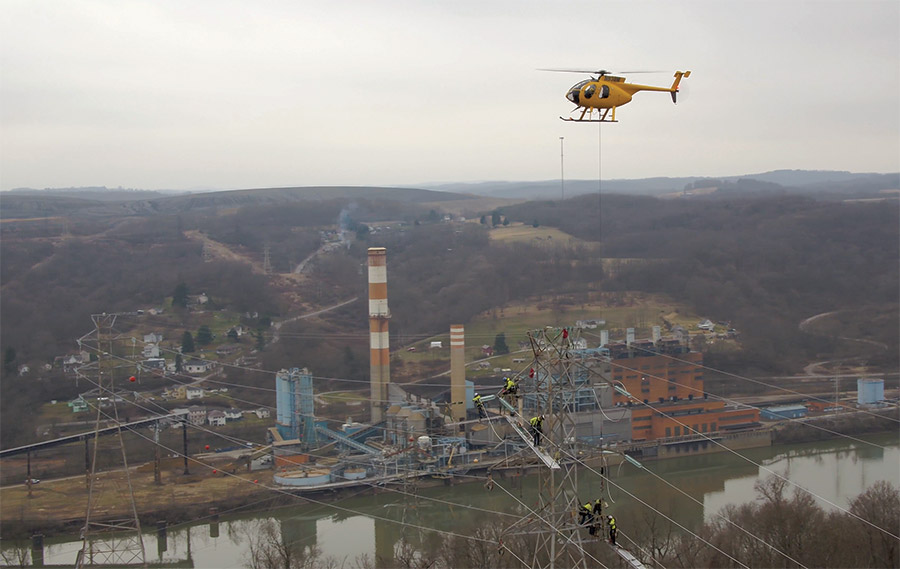
A helicopter assists during line work on a recent Quanta Services project.
Photo courtesy of Quanta Services
The program’s name describes the ability to absorb and avoid severe injury, even when mistakes are made. It is one of several in construction based on what’s called Human and Organizational Performance, but is generally referred to as New View, Safety 2.0, or Safety Differently.
The primary goal is to limit harm from severe injuries rather than giving all injuries equal importance. What distinguishes Quanta’s program is its explicit commitment to New View principles—including an open window the contractor has provided for others to view what it is doing—and the tens of thousands of craftworkers and trainers the firm is helping to educate, including electrical line workers who perform hazardous tasks in the air on lines sizzling with lethal voltage.
The driver of Quanta’s program is Matt Compher, a canny 46-year-old former paper and steel mill laborer. He is exactly the kind of unpretentious ex-blue-collar worker—one acquaintance admiringly calls him a “grunt”—who some believe is best suited to champion safety programs. To make converts of Quanta’s 50,000 craftworkers and staff, Compher starts with a blunt statement. It is meant to dispel any feeling that the program is being enforced by the company “safety police” and it dispenses with corporate linguistic niceties.
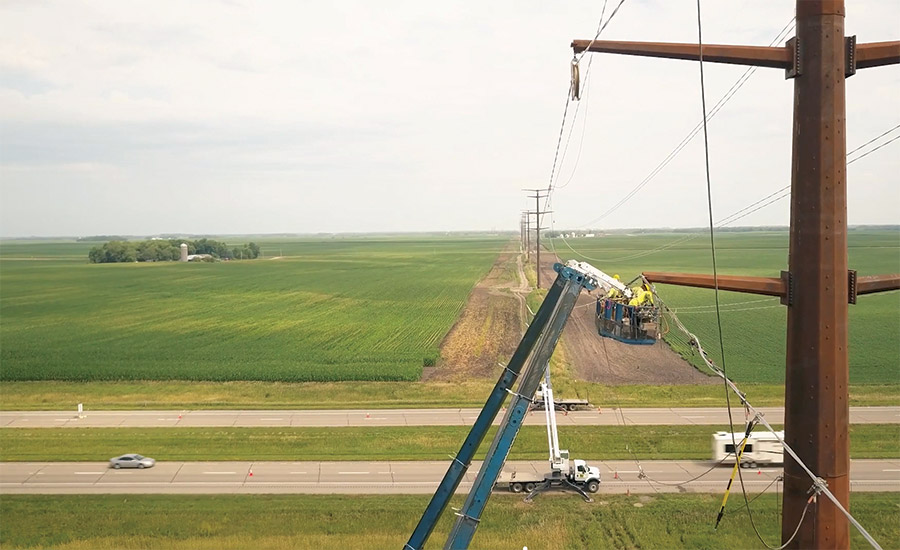
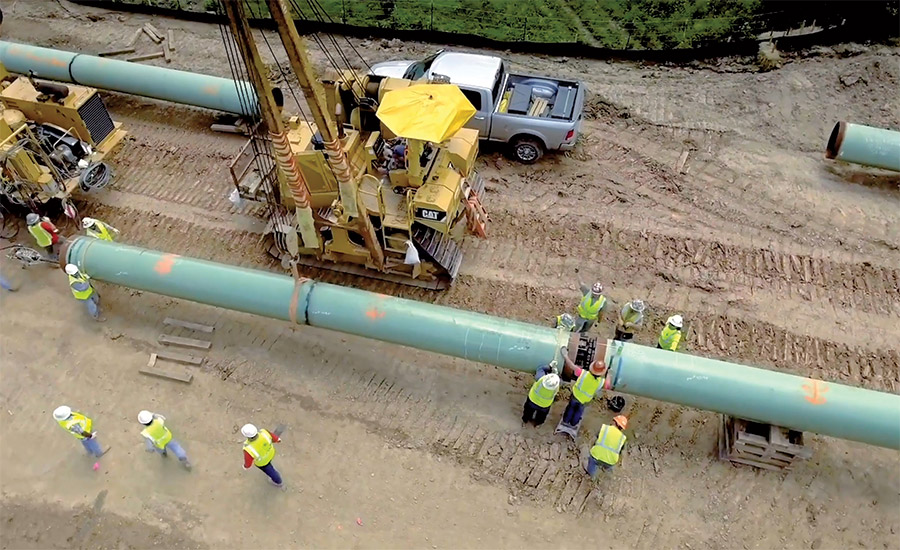

Quanta Services’ market sectors include electrical transmission and distribution, pipelines and renewables such as solar and wind.
Photos courtesy of Quanta Services
*Click on the image for greater detail
“When you walk on a jobsite and ask, ‘what shit kills you?’ it changes the conversation, and our employees understand it and want more,” Compher says. “We’re no longer walking up and saying, ‘the truck is missing a wheel chuck,’ or ‘what gloves are you using?’ With what we say now, the entire culture and relationships change.”
Compher has spent more than three years steering others toward a safety mind-reset that he and several other major construction and energy sector employers have already put themselves through. What makes Quanta different is that it has billboarded rather than soft-peddling key New View ideas. Until now, some practitioners have described such programs as serious and fatal injury programs, and have not explained the underlying concepts.
Among the potential converts are skeptical clients and other contractors who may have seen New View safety as a squishy learning program—including insights from craftworkers about how they stay safe most of the time—one they worried would open the door to trouble by excusing human error.
The naysayers also include companies comfortable doing what they have done for decades. For everyone involved, the long-term success of New View safety means crossing the same conceptual bridge Compher crossed—and taking the focus off the obsessively cultivated low injury rate.
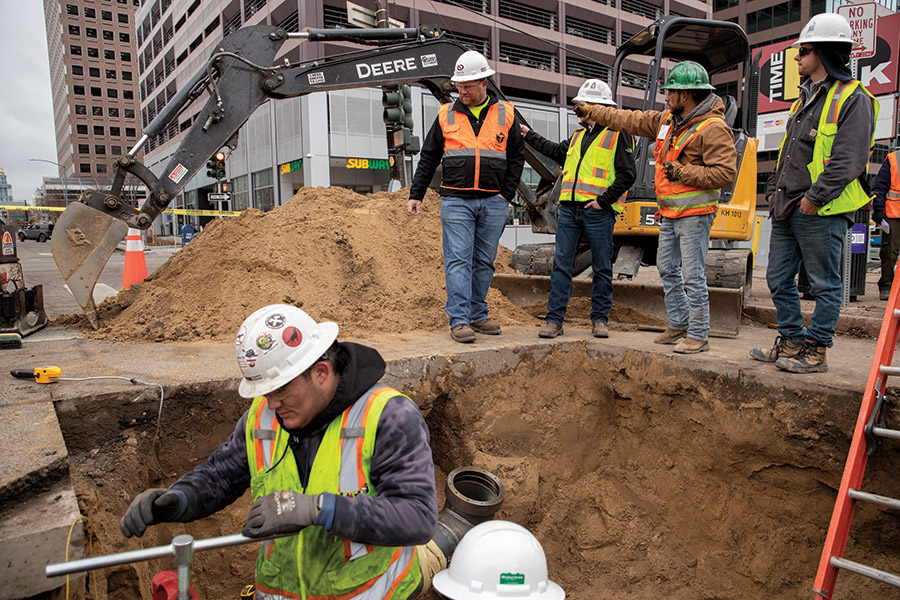
Compher confers with crew members at a pipeline replacement project in downtown Denver. One goal: use equipment and soil as barriers against city traffic that could strike the crew.
Photo by Bruce Buckley for ENR
Those who buy into the approach lift the onus from the employee’s shoulders. They say “people make mistakes; stop trying to fix them,” and instead emphasize hazard removal, energy barriers and engineering controls. Proponents see safety as the ability to absorb with as little harm as possible the inevitable human errors, or, as is often said, to fail safely. “Matt Compher’s group went above and beyond with his Capacity Model program,” says Keith Snead, associate vice president and safety director at specialty contractor Limbach Facility Services.
For his efforts to protect the Quanta Services family and his quest to inject needed fresh thinking into construction safety, the editors of Engineering News-Record have selected Matt Compher, company vice president of safety, health, environmental and quality, as the winner of ENR’s Award of Excellence.
If the changes at Quanta and like-minded companies provide enduring improvements, it could open a new chapter in construction safety that drives down serious injuries as a shrinking labor pool prepares for the forthcoming U.S. electrical infrastructure expansion. It may limit the cost in human life and suffering. It could mean there will be fewer Cayce Seals, fewer lineworkers lost.
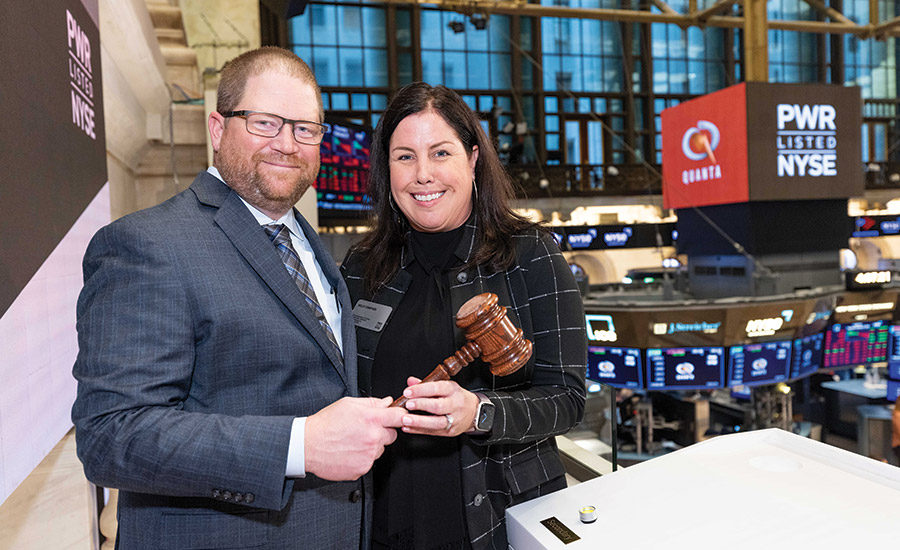
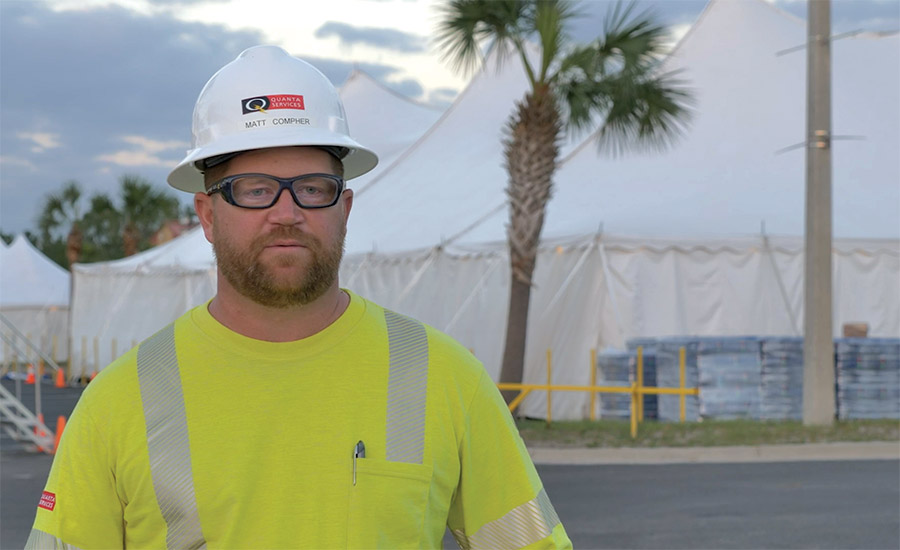
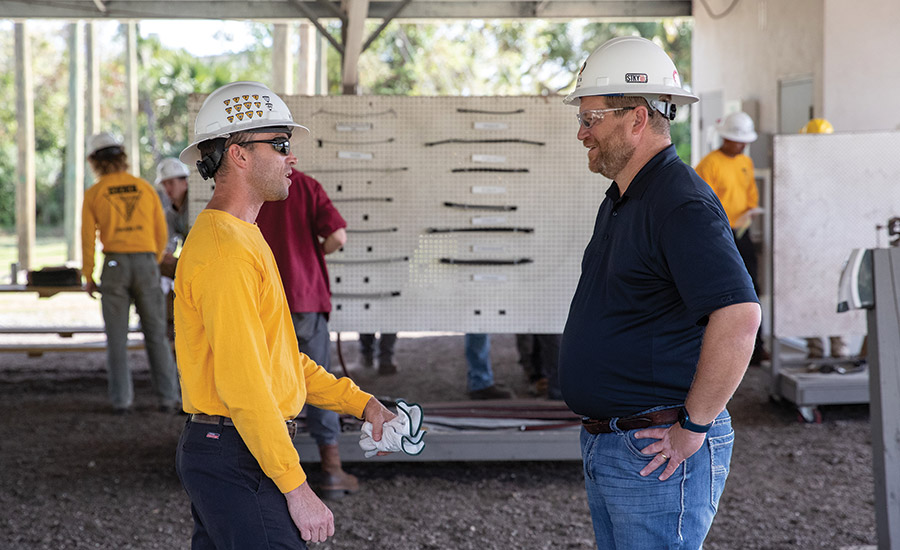
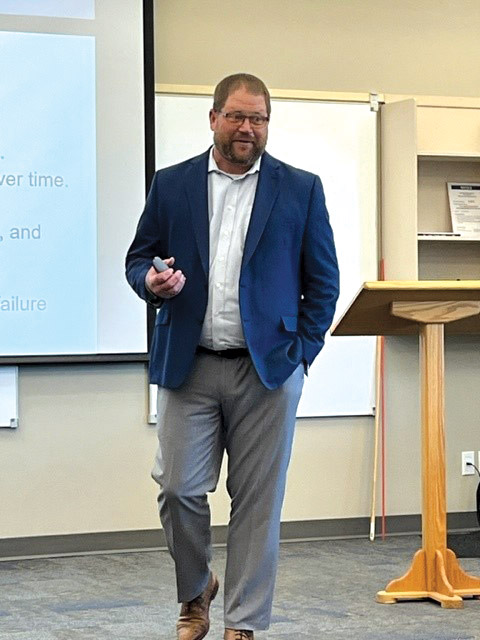
Matt Compher’s life and work require him to fill many roles, which include educator, trainer, colleague, leader, husband and father. He and his wife, Kelly, recently visited the New York Stock Exchange (top left).
Photos (left, middle and bottom right) courtesy of Matt Compher and Quanta Services and photo (right) by Bruce Buckley for ENR.
*Click on the photos for greater detail
Rural Roots
Matt Compher’s own safety conversion was many years in the making.
Chillicothe, Ohio, about 45 miles south of Columbus, is a rural town of farmers, loggers and mill workers in the Scioto Valley. Its main economic engine, aside from truck maker Kenworth, is the former Mead Corp. pulp and paper mill now owned by a private equity company but still referred to by many locals as Mead. It employs about 1,000, and like other paper mills, emits a sulfury scent into the air.
In Chillicothe, Compher recalls that you could earn $40,000 a year to start and go up from there. And for sportsmen like Compher, there was decent hunting and fishing nearby.
Robert Compher, Matt’s father and a retired mill worker, still lives with his wife, Linda, on a small family farm in nearby Bourneville. They remain active in the same small, Bible-focused Christian Union Church where every Sunday they took Matt and his older brother. “They had no choice,” says Linda.
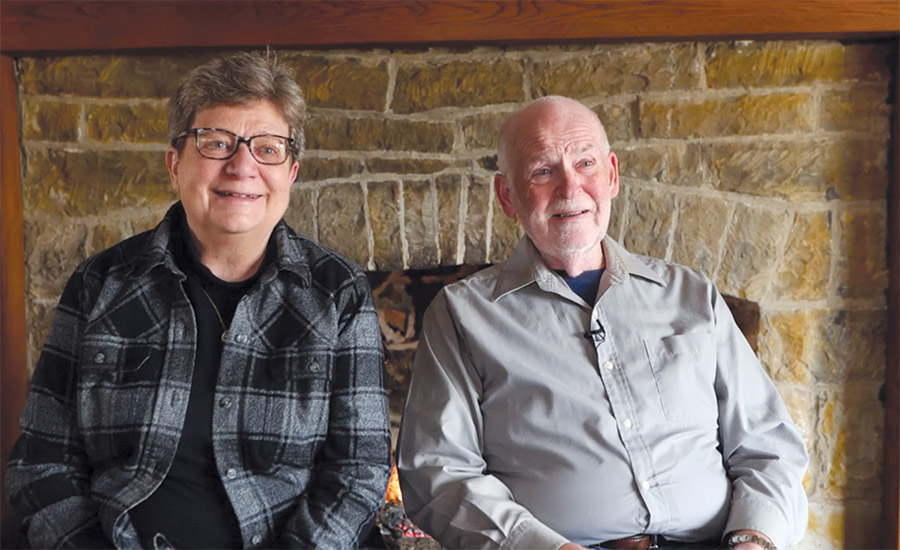
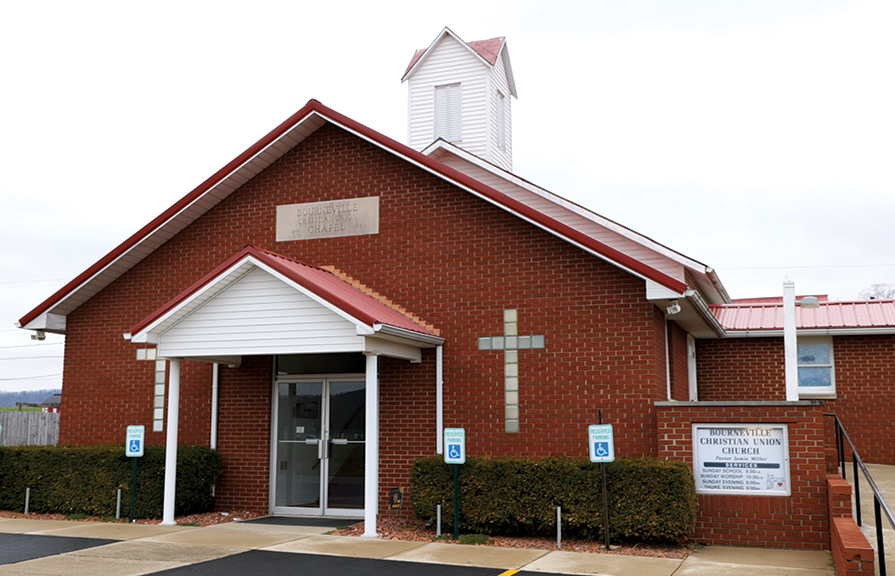
Parents Linda and Robert remain members of the Bourneville Christian Union Church, an integral part of Matt’s early life.
Photos by Luke Abaffy for ENR
*Click on the photos for greater detail
From the start, he was an impetuous and not overly studious child, Compher’s parents recall. Assigned to read “The Call of the Wild,” he refused—so Linda read the book to him. Yet when he put his heart into something, including a church program to assist older neighbors, Compher always wanted to do it well. In that spirit, he named the program, Help Every Last Person, or HELP, displaying an early fondness for acronyms.
Although Compher originally aspired to a paper mill career, his first consistent post-high school job was at a steel mill then called Union Spring, now known as Barber Spring. His early workdays involved tapering the ends of 20-lb steel bars—3,200 bars per eight-hour shift—using tongs to furnace heat the bar to 2,800° F and then immerse it in a quench tank. The job was done in a foil apron with heavy gloves at an hourly starting pay of $7.10.
Safety, to put it gently, wasn’t as much of a priority as it is today. “My co-workers were being hurt at an alarming rate,” says Compher. “I wanted to take some action.” He ran for and was elected as a safety committeeman for the United Steelworkers Union, and helped the staff start a safety program.
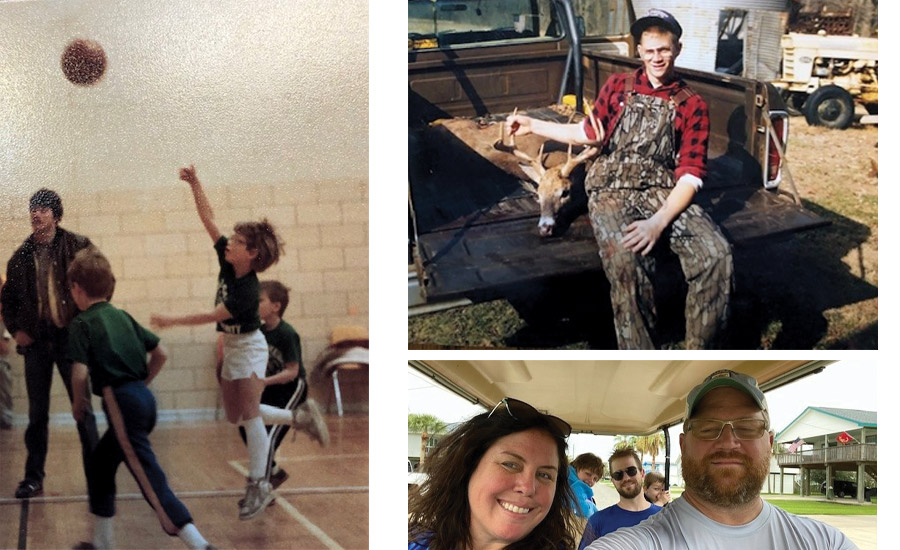
The Compher family has roots in rural Ohio, where young Matt (left, top right) learned to love sports and hunting, met high school sweetheart Kelly. They have two sons, Seth and Eli, and two grandchildren.
Photos courtesy of Matt Compher
Compher and his high school sweetheart, Kelly, married at age 18 and started a family. Supporting them was Compher’s first priority, and the paper mill was still his goal. But before he could go to work there, he first had to reach an agreement—with his father. When the younger Compher was interviewing for a job at the paper mill, his father told him, “If you come in, I want you to have a plan to get out.”
Compher says, “That was a big moment. I went to work but I also started part-time college classes.”
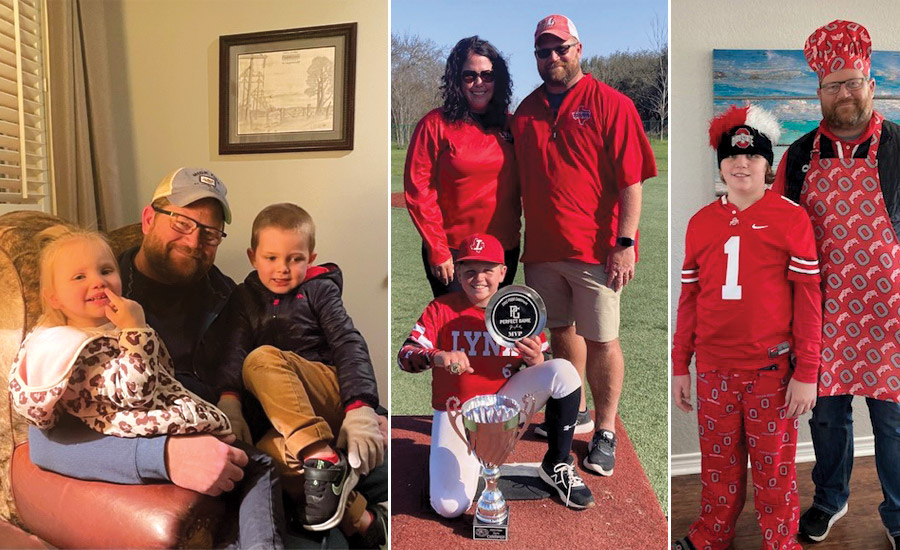
Photos courtesy of Matt Compher
While in the paper mill, Compher became a department union safety leader and began performing safety training. On many occasions he would trade his day shifts for night shifts, working 11:00 p.m. to 7:00 a.m. in the mill so he could provide safety training for new hires from 7:30 a.m. to 3:00 p.m. Soon, Compher also began applying for any safety job posted online, using his mother’s computer since he and Kelly did not yet own one.
After his annual pay with overtime had reached $50,000 a year, Compher finally landed a safety manager’s job—for $15,000 less annually—at MPW Industrial Service, a regular contractor at the AK Steel plant. It had a poor safety record and was starting a turnaround under an experienced safety manager. Among his duties, Compher helped support and manage a contractor safety program.
Compher’s first energy-related work and sustained contact with contractors came in 2004, when he landed a job at American Electric Power, a large utility. “I went there to help them set up a contractor oversight system for transmission projects, which included evaluating all the contractors on a bid list,” says Compher. One firm was North Houston Pole Line, the family company of Quanta Services’ CEO Earl C. “Duke” Austin Jr.
His next job was a seven-year stint at Irving, Texas-based PLH Group, where he oversaw safety, health and environmental matters for the contractor. Like Quanta Services, PLH builds both electrical lines and pipelines.
Compher was happy at PLH, but then learned Quanta’s safety vice president was thinking about retiring. What finally convinced Compher to join Quanta in 2016—and move his family to Houston, his sixth job-related relocation—was a meeting with Austin, who showed his passion for improving the company’s safety performance. “We have to lead the industry,” Compher recalls Austin saying.
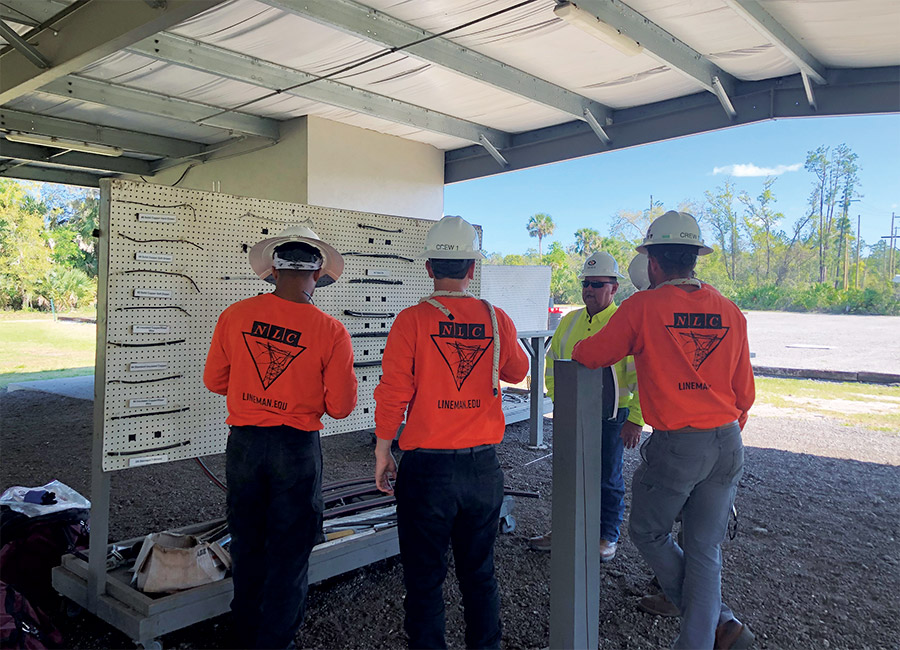
A veteran trainer is shown here with trainees at the Northwest Lineman College campus in Edgewater, Fla., while a rigging lab is held nearby.
Photo (above) by Richard Korman for ENR
At the time, Quanta’s injury rate was fine by most industry standards, but every few years or so it had a severe or fatal injury. After the firm hired Compher, he started to review different safety programs being used and all the different philosophies behind them.
“Up until that point,” says Compher, “my career consisted of the typical concerns. If we had a hand injury, we’d devise a program for hand safety. If someone fell, we’d create one for falls.” So began his self-directed construction safety re-education.
By then, New View safety had already become a well-developed academic subject. Scholars that included Sidney Dekker and Todd Conklin, the latter who has since done some Quanta consulting, had been making effective use of websites, podcasts and videos to get their message across.
Interest in New View safety ideas also was rising, with several large contractors adopting serious injury and fatality programs based on New View concepts. At least two large contractors, Brasfield & Gorrie and M.C. Dean, have employed New View safety ideas for many years. Still others use different versions or parts of it through their captive insurers. Some oil and gas companies and hospitals also employ New View safety. Non-punitive incident reporting has been important to commercial passenger aviation for decades.
In some safety discussions, dissatisfaction with behavior-based safety was also crystallizing. Some saw the popular “zero injuries” and “zero incidents” goals as self-defeating perfectionism that inhibited incident reporting and honest discussion of work practices.
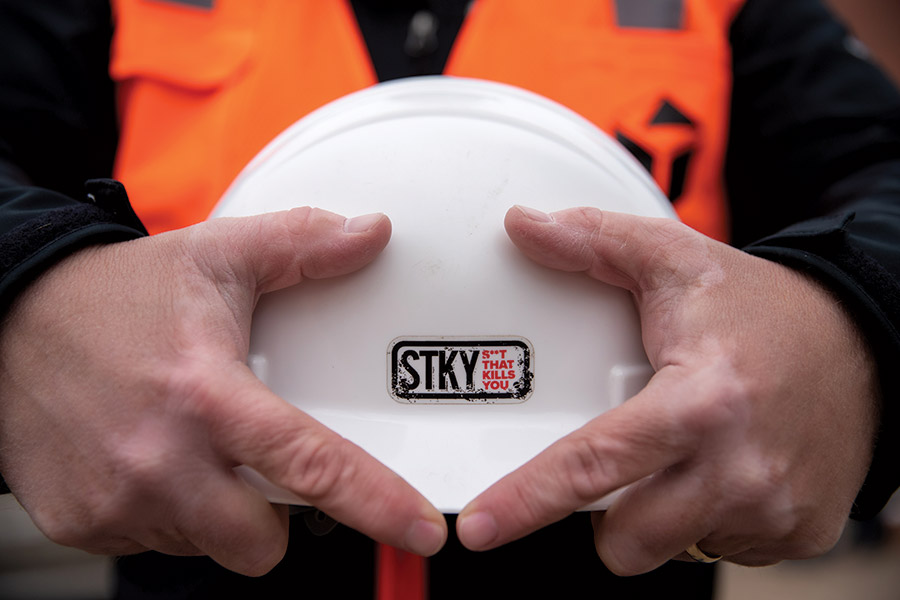
STKY, when used in the form advocated by Matt Compher, has a shock value, but also mioves the conversation away from spotting safety rule violations to concern about the workers and what can inflict severe harm.
Photo by Bruce Buckley for ENR
Others saw that encyclopedic safety compliance manuals were going unread, and that simplifying as much as possible would yield better results. Still others agreed with New View adherents that workers who committed safety violations usually had reasons for what they did and that disciplining them, or treating them as bad apples to be weeded out, obscures the employer and work system’s roles in shaping performance.
At its worst, behavioral safety after a mishap devolved into a tendency to quickly dismiss workers—sometimes even before an investigation had been concluded. Behavior-based safety’s focus on compliance sends the message to workers caught violating a rule that they are “stupid,” says one long-time contractor safety director.
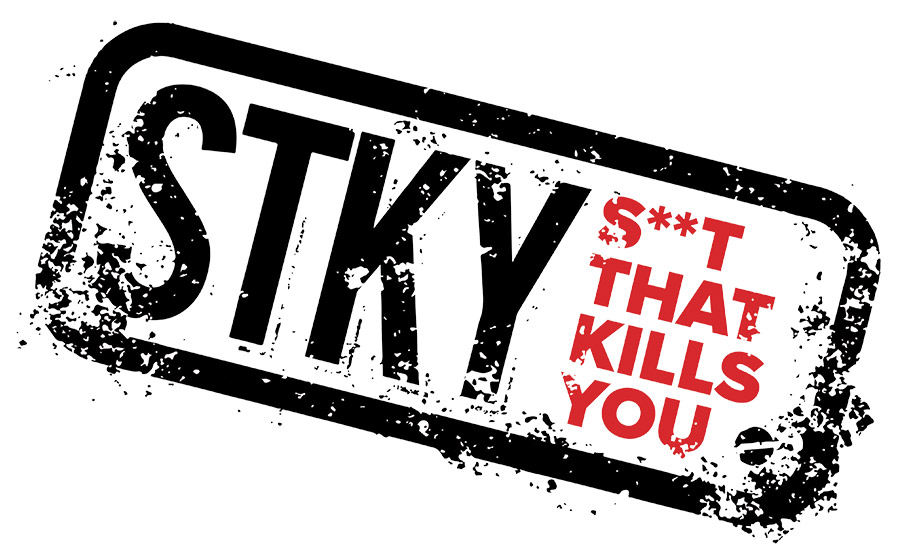
STKY graphic courtesy of Quanta Services
To some New View proponents, there is a strict, mutually exclusive split between behavior-based and safety centered on a fundamental disagreement over how much human agency is involved in any workplace incident. But for others, that line has become blurred. Some consultants theorize that behavior-based and New View safety could fit snugly together into an effective system.
While behavior-based safety theories can be traced to the work of psychologist B.F. Skinner, New View ideas have roots in human factors theory and 19th century time-and-motion studies. But more recently, some New View academic work has delved into “just culture” models, which involve learning, designing safety systems and managing worker choices.
With an emphasis on learning teams that include crew members and staff experts, New View programs add another layer to the usual tailgate talks and training classes.
But the effort in just getting started should not be underestimated. Rob Berryman, senior safety consultant to captive insurer American Contractors Insurance Group, told risk conference session audience in November in Las Vegas that it took 90 days for the captive’s members to agree on what would be classed as a serious injury. It finally settled on those that are life-threatening, life-altering or life-ending. New View safety also could be a challenge for building construction managers or general contractors that subcontract work to dozens of firms.
There are other obstacles. The federal government promotes hazard elimination through Prevention through Design programs. But when the U.S. Occupational Safety and Health Administration cites employers, companies often defend themselves by arguing that the violation was the result of unpreventable employee misconduct as a way to avoid all or part of the penalty, according to Travis Livermore and Jeremy Presnal in a recent ENR commentary. OSHA also encourages participation in Voluntary Protection Programs to maintain injury and illness rates below a certain level. Owners often want to know that all incidents will be prevented and that careless employees won’t be on their jobsites.
How STKY Started and Why It Works
Of all the ways in which safety messages are transmitted, few have had such instant appeal as the acronym STKY and its variants. The exact words can vary depending on who is using them, but they have an impact necessary in an age of messaging overload, where memes and factoids spill from media like gravel from a dump truck.
First, the words themselves.
In a more polite version, the acronym stands for “stuff that kills you.” But Matt Compher, safety vice president of Quanta Services, is a devoted purist who prefers “shit that kills you” as more emphatic. “There’s a shock value that resonates,” says Kristin Oostra, chief education officer at Quanta Services’ National Lineman College. Quanta has trademarked two versions of the STKY four-letter acronym.
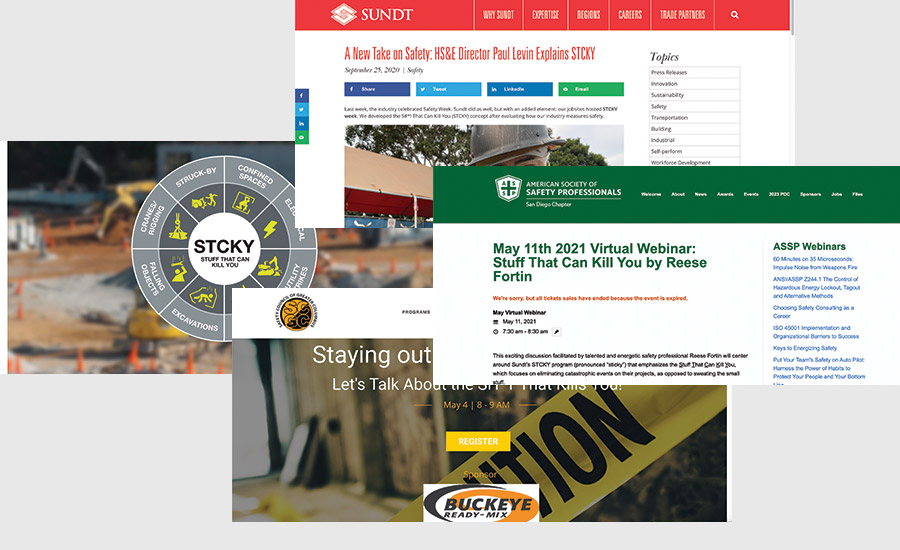
Website images (clockwise From Top) courtesy of Sundt; American Society of Safety Professionals San Diego Chapter; The Safety Council of Greater Columbus; Brasfield & Gorrie
Other companies have their own STKY-type programs. At Brasfield & Gorrie, which uses a five-letter version, STCKY, about 45 senior executives and staff meet each Monday to discuss any STCKY event that had the potential to cause serious injury or fatalities, whether or not there was an actual injury, says Troy Ogden, vice president for safety and learning. In an age of overloaded schedules, STCKY helps busy people by putting “the most important stuff at the beginning” of any safety discussion, he says,
Messaging in general has been an integral part of safety, including the long standard behavior-based safety programs and the often-used “zero incidents” and “zero accidents” posters. One behavior-based safety poster was a list of the “dirty dozen” possible causes of incidents, including stress and fatigue.
How did STKY start? Compher says safety leaders, including those from Brasfield & Gorrie and Sundt, had been kicking around messaging that could be used to help with their safety ideas. They had all become familiar with research on high-energy events and fatalities.
But Compher says that in exploring the words separately with his Quanta colleagues one day, former firm training director James McGowan hit upon the STKY version of the acronym. It seems destined to have a life that is only just beginning.
By Richard Korman
Electrifying Work
More dependent than ever on reliable electricity, few Americans appreciate what overhead line workers confront to make that happen. A line worker’s daily commute often includes a trip up a 50-ft-high power pole or a ride in a aerial lift to an open-air “office” roofed by high-voltage lines. Storms that have damaged poles and transmission towers and lines make the work trickier. Compher first came across New View safety ideas while still with former employer PLH. “I was a big zero person,” he remembers. “What other goal was acceptable? You had to say zero.”
In much of his safety career until then, the feeling of success from falling injury rates, Compher explains, was undercut because “all of a sudden we’d have an event, a fatality or an amputation, and we’d evaluate lagging indicators. We might have some effect somewhere but we weren’t addressing the significant events.” he continues: “I had to get to the point where I decided that the pyramid”—Heinrich’s Pyramid, the now discredited model that says addressing small safety incidents and injuries inevitably helps prevent fatalities—“ain’t right.”
His ears were open, as were others at Quanta.
Compher’s team would listen to New View proponent Conklin’s podcast on Monday morning drives to work when the safety expert would explore subjects such as “Stop Work Authority,” suggesting that “Start Work Authority” was a better idea. When the Quanta team arrived at the office, says Compher, “we would argue about what we’d heard, and then we’d read a chapter in his book, and we just got enthralled in it.” Once convinced of the direction for Quanta’s safety program, Compher says his first task was to seek approval from the CEO.
Austin says he hired Compher because he was stern but fair in dealings with craftworkers, did not play favorites and valued the welfare of Quanta employees, treating them as family. “His dedication to getting people home every day was necessary to work with our organization and we made the right choice,” says Austin. A rare shared airplane trip back to company headquarters provided the opportunity for Compher to explain the new safety plan.
Austin gave it a green light—becoming perhaps Compher’s most important convert. “We decided to quit managing to the numbers and to manage to protect lives and make people in the field safer,” says Austin, who had been through fatalities at his family’s company, “including one of my dad’s best friends.”
The Capacity Model, and the use of the long-established energy wheel displaying the most dangerous hazard types, fit Quanta well.
But the communications challenge was huge—starting with Quanta’s size and numerous operating units. Founded in 1997 by John Colson, Quanta combined four companies and has since added 200 more. It reported net income for 2022 of $491 million on $17 billion in revenue, up from $486 million on $13 billion during the prior year. About two out of every three dollars of revenue is utility-related.
No construction company—and none in Quanta’s three key markets of electrical power and communication lines, pipelines, and renewable energy—has tried a conversion on a similar scale. None appears to have created so many training materials and programs and so many website pages, PowerPoints and videos. None has as openly championed New View principles, using the Capacity Model to plan and learn from work.
A Training Staff Ready for A New Plan

Photo by Scott Hilling for ENR
The sound resembles baseball infield chatter under a spring training sun.
In a practice field spiked with utility poles outside the Northwest Lineman College campus in Edgewater, Fla., yellow-shirted lineworker trainees strapped to the 55-ft poles exchange shouted instructions and encouragement with teammates, called groundmen, and trainers below.
“No slack, no slack,” crosses with “hey, watch that line,” as the team hoists a transformer to the top. The meadow then falls quiet for a minute until cranking sounds break through as a trainee ratchets the nut on the thru-bolt holding the transformer. In the background, 100 yards away, other trainees are maneuvering along a 40-ft-high transmission tower crossarm.
What’s being transmitted isn’t electricity. It’s craft skill with an extra layer of safety training that is part of the Capacity Model program championed by Quanta Services safety vice president Matt Compher.
When Quanta decided to implement the program in 2018, it already had a robust, capably staffed training infrastructure. Educational writers, editors and website content developers were already part of the training and communications staffs.
Each year, the college trains 17,000 people as pre-apprentices and apprentices in areas that include safety and gas operations. The Electrical Lineworker Program runs 15 weeks and is offered at Edgewater and at campuses in California, Texas and Idaho, where the college started. Tuition ranges from $20,932 to $23,038, depending on the location.
In adult education for craftworker trainees, the material must be balanced evenly between text and graphics, says Kristin Oostra, chief education officer for Quanta and the college. Separate materials are prepared for the company’s power and pipeline crafts because training concepts are best learned in context, she says.
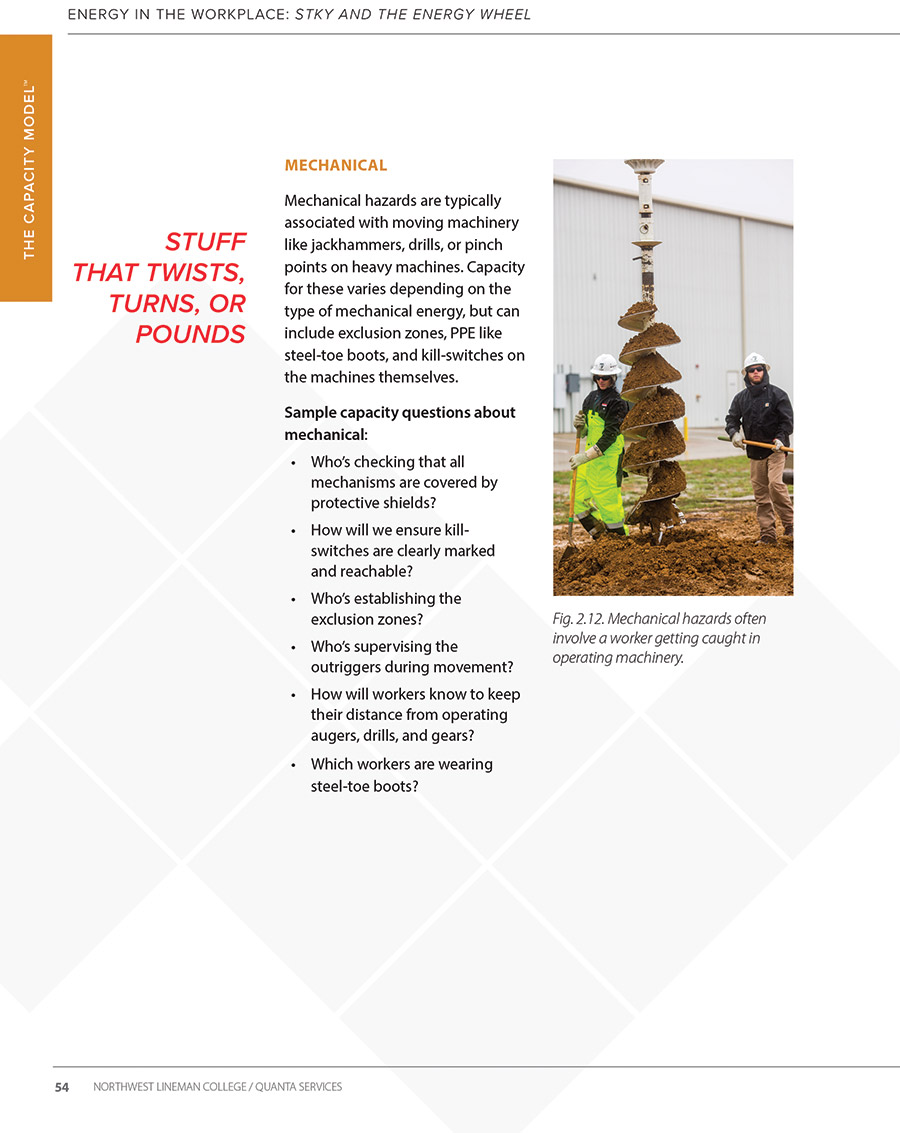
Image courtesy of Quanta Services
Aaron Howell, a former lineman who founded the Northwest Lineman College and now is Quanta’s chief learning officer, joined Oostra and other Quanta staff at the Edgewater campus in March to talk with ENR about training.
“It’s an organization of people who have a deep, deep passion to train craft,” says Howell. Compared to other types of education, there is little “on the shelf” to explain how best to do it. As a result, he says, “we all feel like we are revolutionaries making it up along the way. What’s so exciting about the Capacity Model is it fits in really well.”
Inside the Edgewater campus indoor training and office building, another group of trainees, this time with feet firmly on the floor, is being led through a practice session on installing and replacing electric utility meters. Near the meters are poles and cross arms, with conductors capable of carrying low voltage. On these, trainees practice using hot sticks—one method of working safely on energized lines.
On a wall inside the college building, a poster explains Quanta’s technical educator’s creed, which includes creating a “learning culture,” while another poster contains the lineman’s—there are linewomen, but male pronouns still are used in many places—professional creed: pride, camaraderie and spirit. The poster also has line work statistics, including the median annual wage (not including overtime), that now is $86,000.
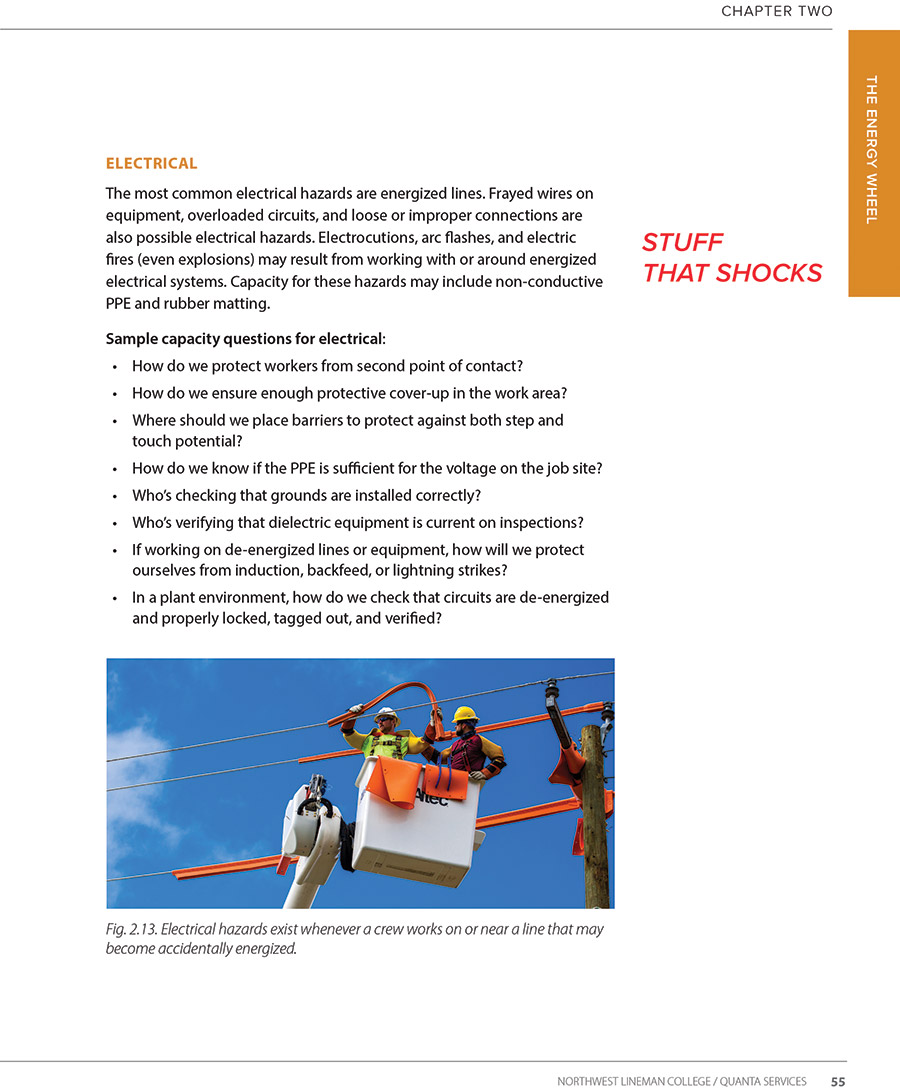
Image courtesy of Quanta Services
Unlike the intensive craft training provided at the college, Quanta’s seven basic principles of human performance safety are available to the public on the company website: People make mistakes; failure can occur safely; context influences behavior; violations are rarely, if ever, malicious; incidents can stem from normal deviations; management’s response to failure matters; and learning is a deliberate improvement strategy. These principles are not specifically discussed with trainees and apprentices. They are baked into the discussions of subjects such as proper grounding and use of ropes and slings.
Outside again, Compher coaches a trainer running a rigging lab on how he has organized the job briefing’s hazards, preventative measures and mitigations. “Read it to me,” says Compher. The trainer reads an exhaustive accounting of what can go wrong and ways to prevent or limit damage. He covers everything from hanging a transformer to preparing for heat stroke.
Another trainee then prepares to climb a pole. The task involves a multistep safety process started by testing the pole with a hammer strike, listening like a piano tuner for the solid sound that indicates the wood isn’t rotten. Soon after, he begins another climb to the top.
By Richard Korman
Converting One Client at a Time
What makes Compher stand out is his devotion to communicating New View principles more effectively, in certain ways, than some of its most distinguished theorists and consultants.
When speaking to craftworkers, his emphasis is “consumability.” When speaking to Quanta clients who for years have based their estimates of a contractor’s safety performance solely on compliance, injury rates and punishment of those who violate rules, his strategy is different. “We talk to them about our philosophy, how it’s making a difference and influence them as much as we can,” says Compher. “But at the end of the day we own our safety and we are moving forward.”
Compher never pretends to be a one-man band. In addition to the firm’s existing training staff, it hired in 2019 Barbara Cristinziani, a veteran human and organizational performance expert. She reports to Compher, as do some corporate-level employees and regional leaders on safety matters.
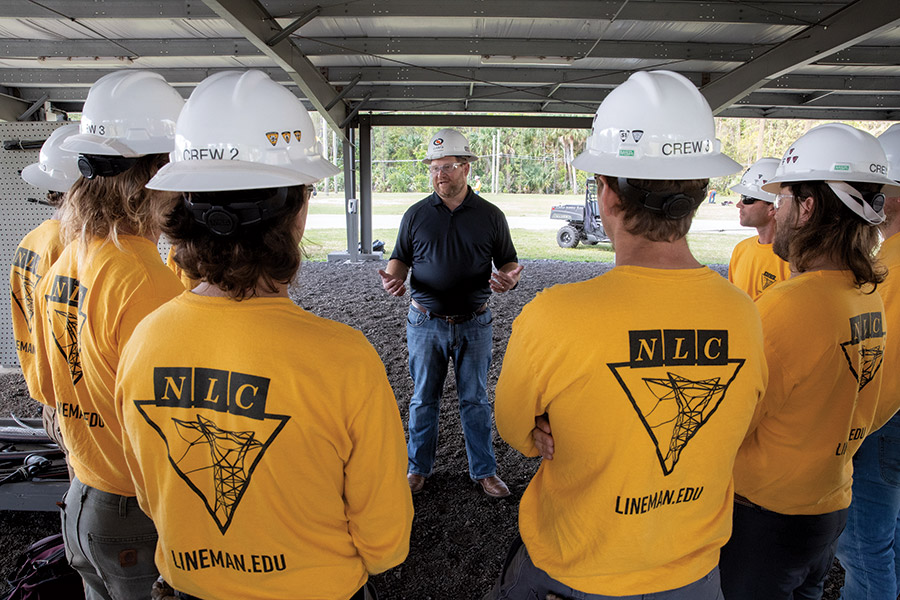
Compher, shown chatting with line worker trainees, has the respect of peers and colleagues in the safety profession who admire his passion as well as his talents as a communicator.
Photo Credit: Bruce Buckley for ENR
Cristinziani has been busy meeting with crews and supervisors, often to help guide the conversations in a productive direction toward learning when there are issues or something goes amiss. She noticed over time that foundation crews in different regions who were not in regular communication and who used a certain type of foundation drill were suffering finger amputations. As a result, she organized a learning group that decided to design its own drill, on which the sliding parts that require adjusting can no longer trap a finger. Instead of trying to fix people, Compher’s and Cristinziani’s learning group disciples are fixing the drill problem by designing a new one.
Crew members and supervisors seem to appreciate the overall safety plan. Noel Carmona, a pipe work foreman in Denver, says he enjoyed his prior employers, but Quanta and the Capacity Model program are different. “This feels like another level,” he says.
Compher’s industry colleagues and acquaintances are impressed with his pilgrim spirit. Troy Ogden, Brasfield & Gorrie vice president of safety and learning, has spent years applying New View ideas to his company’s safety program. He says Compher has “given it energy” at Quanta, and its safety team is “sharing openly” what its members are doing.
“If you are not paying attention to what Quanta has done to bring New View to life, you are doing your company a disservice,” says Ogden. “If you aren’t having that conversation and still showing the [Heinrich safety] triangle, you are not helping.”
Another booster is Gary Lakey, vice president of safety and labor at Xcel Energy. His own company’s journey with New View is going nicely and he recalls a meeting with Compher in 2019. “We had the same goals, the same dream of ending fatalities,” Lakey says. Compher is “good at selling [his Capacity Model program ideas] because he’s passionate about what the result of selling it is. He’s selling safety. He’s selling saving lives—and who doesn’t want to join that team?”
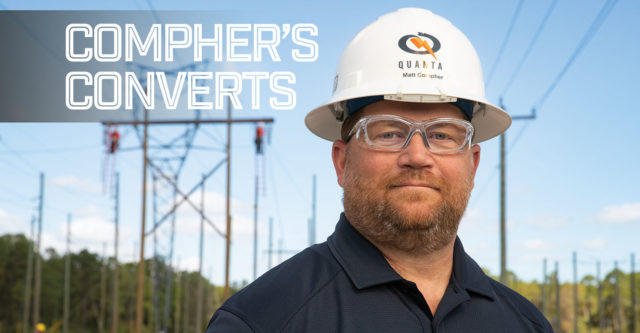






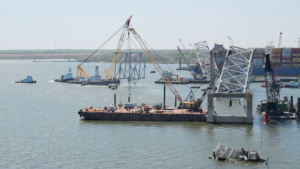

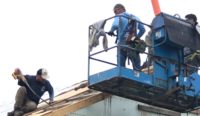
Post a comment to this article
Report Abusive Comment